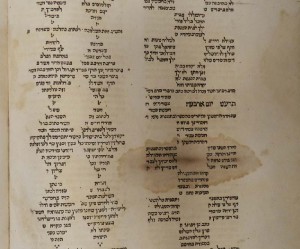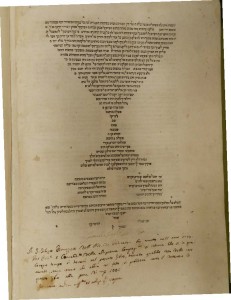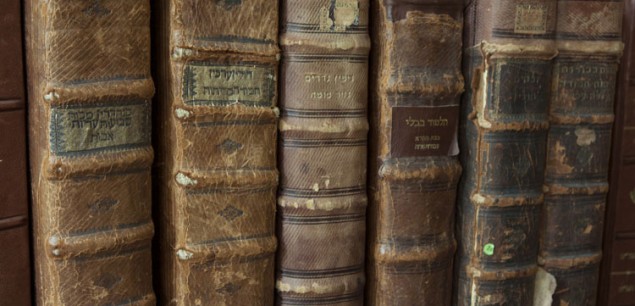A Passion for Rare Sefarim: Q & A With Rabbi Eliezer Katzman
Expert collector Rabbi Eliezer Katzman, a consultant and appraiser of Judaica and Hebrew books for Kestenbaum & Company, has also worked for Sotheby’s, Christie’s and other auction houses. Rabbi Katzman, who lives in Brooklyn, New York, has appraised the collections in the Rare Book Room of the Mendel Gottesman Library of Hebraica/Judaica at Yeshiva University, the collection in the Jewish Public Library of Montreal and the rare books and manuscripts of the Annenberg Research Institute in Philadelphia. He has published many scholarly articles on Jewish history, Jewish law and bibliography and serves as associate editor of Yeshurun, one of the foremost scholarly biannual publications on Jewish law, history and bibliography.
Jewish Action: Tell us about your extensive library of rare sefarim and how you became involved in collecting.
Rabbi Eliezer Katzman: I own an eclectic collection of about 10,000 sefarim. Originally I bought sefarim for my own learning. If I had to prepare a shiur and needed a sefer, I couldn’t go hunting for it in shul late at night. [But] my interest in rare sefarim began with my father, Rabbi Asher Katzman, who was a rosh yeshivah at Yeshiva Torah Vodaath. He had between 30,000 and 40,000 sefarim. I inherited the bug. A lot of the sefarim I have are from him; others I bought on my own.
JA: Where do you keep your vast collection?
RK: I have sefarim filling my garage, shed and basement.
A young collector called me once, lamenting his shalom bayis problems; there was no room left in his house. He had run out of shelf space and began piling sefarim on all of their chairs. His wife complained that there was no place to sit. He solved the problem by purchasing the Otzar HaHochma digital library that has approximately 71,000 sefarim scanned in page after page. He told me it saved his marriage.
JA: What are the most important factors when assessing a sefer’s market value?
RK: The first factor is obviously age. The rarest books are known as incunabula—books printed before 1501, when printing was in its infancy. Jewish incunabula are especially rare. For example, a Jewish book printed in 1492 is worth considerably more than a non-Jewish book from the same period. The Jewish people studied their books throughout the exiles, so complete, intact Jewish books are extremely rare. Jewish books were often burned over the centuries—another reason they are rare. There were books printed right before the Holocaust, most of which were destroyed by the Nazis. Those that survived are very valuable.
Currently, I write the descriptions of the sefarim and manuscripts featured in the Kestenbaum & Company catalogs. The catalogs describe the importance of each sefer, when it was printed, its condition and what it’s worth. If a famous person wrote marginal notes in a sefer, it increases the sefer’s worth. A sefer that once belonged to Rav Moshe Feinstein that contains his notes is worth much more [than a sefer without notes]. Rabbi Baruch Frankel-Teomim, known as the Baruch Taam [1760-1828], the father-in-law of Rav Chaim Sanzer, wrote notes in the margins of all his sefarim. Recently, Rabbi Baruch Shimon Schneerson, the son-in-law of Rabbi Dov Berish Weidenfeld, the Tchebiner Rav, published a collection of the Baruch Taam’s marginal notes on various sefarim.
There are two categories of rare Jewish books: printed sefarim and manuscripts. Many people view a letter or manuscript by a Chassidic rebbe or the Chofetz Chaim as intrinsically holy. [Nowadays,] a handwritten letter by the Chofetz Chaim. . . is worth approximately $20,000. Even a typed letter with only his signature may be worth a few thousand dollars.
[To command a high price,] a sefer has to be complete; a book missing a title page is worth substantially less. It should be in good condition (not wormy). Noncollectors often assume that older books are in worse condition than later ones. But that’s not necessarily the case. After 1860, chemicals were added to paper. That’s why books from later periods often have brittle pages. The paper used in earlier books—rag paper—remains fresh.
Another factor that determines the value of a sefer is the element of mystique. For example, a siddur was published in Amsterdam with the kabbalistic commentary of Rabbi Yeshaya Horowitz, known as the Shelah HaKadosh. There’s a haskamah (letter of approbation) in the siddur from the Bach, who writes that anyone who prays from this siddur will have his prayers answered. Collectors pay a lot of money for it. The Shelah probably meant that anyone who studies his commentary and adheres to the suggestions will be answered. But people will pay between $20,000 and $30,000 for the siddur.
First editions of Chassidic sefarim also command high prices. Chassidim like to have a connection to their rebbes and their dynasties. In the town of Slavuta, Ukraine, Rabbi Moshe Shapiro was the town’s rabbi and printer. He was a descendant of the famous Chassidic rabbi, Rabbi Pinchas of Koretz, a disciple of the Ba’al Shem Tov. Chassidim view any sefer printed by the descendants of his family as imbued with inherent kedushah. For example, a Tehillim printed in Slavuta could go for $5,000. They are in great demand, especially by Skverer Chassidim, who are willing to pay top dollar for them.
JA: How do collectors go about finding rare sefarim?
RK: When I was growing up, there were still sefarim stores on Manhattan’s Lower East Side that sold many out-of-print sefarim. There was a time you could get [these works] at a relatively low price. In Eretz Yisrael today there’s a rapidly growing industry of book dealers selling antique books and manuscripts. There are a lot of sheimos and old sefarim found in many of the old houses in Yerushalayim. I know a book dealer in Israel who finds out when a home is being demolished and makes a deal with the builder to give him entry to the attic before the structure is torn down. He’s discovered many ancient sefarim and letters this way. [He recently discovered] precious items owned by Rabbi Zundel of Salant, who lived in Jerusalem in the mid-1800s. In 1948, when the Old City was destroyed, a number of his sefarim survived and were preserved by members of his family. A recent auction featured letters and articles that belonged to him.

The rarest books are known as incunabula—books printed before 1501, when printing was in its infancy. Jewish incunabula are especially rare, says Rabbi Eliezer Katzman, an expert in Hebraica and Judaica. Seen here is an example of Hebrew incunabula that is very valuable. Colophon of Arba’ah Turim: Orach Chayim, published in Mantua, Italy, by Abraham Conat, ca. 1476. Images courtesy of Yeshiva University, Mendel Gottesman Library.
JA: With the advent of the Internet and digitization, does actively building up one’s physical library really make sense?
RK: In the past, if someone needed certain sefarim, he had to go to four or five different libraries. Some were found only at Oxford University or the British Museum in England or at the National Library of Israel at Hebrew University in Jerusalem. In America, some of the researchers use the library at Yeshiva University and the Jewish divisions at The New York Public Library and at Harvard University. Harvard has one of the largest collections of Hebrew books—about 60,000 to 70,000 works. The Library of Congress also has a large collection. Nowadays, you can go to a site called Hebrewbooks.org, which has about 50,000 digitized sefarim. One can also purchase CDs containing thousands of sefarim.
However, there is a tremendous advantage to having access to a physical sefer. Not everything is on the Internet, and some people enjoy holding a 300-year-old sefer in their hands; it enables them to feel a greater connection to the author and the time period.
JA: What do you think of those who collect sefarim primarily as a hobby, but not for personal study?
RK: They say of collectors in general that it’s the excitement of the hunt [that drives them].
One of the foremost collectors of rare Jewish books is Jack Lunzer, a retired industrial diamond merchant in London, who has one of the most valuable collections in the world—some 13,000 Hebrew works. In 2009, Sotheby’s exhibited a portion of his massive library, which included the most prized work of his collection, the first complete printed Shas, known at the Bomberg Shas. It previously belonged to King Henry VIII. As is well known, the king didn’t have any male heirs and wanted to annul his marriage so that he could remarry and attempt to have a son. [In order to legitimize his divorce,] an advisor informed him that he may find a solution in the Talmud. He ordered a copy of the first Shas, printed in the early 1500s. He received a deluxe edition, bound especially for the king. Eventually, he gave it to the Church of England. Mr. Lunzer wanted to own this Shas and was initially unsuccessful in convincing the church to sell it. He bought the original charter of Westminster Abbey and persuaded the church to sell him the Talmud in exchange for
the charter.
JA: Do you have any favorite sefarim?
RK: One of my favorites is the mussar sefer Marpe Lashon (Healing of the Tongue) by Rabbi Raphael HaKohen, rabbi of Hamburg, Germany. In his youth, Rabbi Chaim Volozhin was one of his disciples. He is famous for his responsa and chiddushim on the Talmudic tractates of Kodshim. The sefer, printed in 1790 in Altona, Germany, covers topics such as teshuvah, humility, tzedakah, Yom HaDin and various other topics. Although I already owned subsequent editions, as the sefer had been republished in Vilna and after that, in America, I decided to buy the original for two hundred dollars. Later, when comparing the editions, I observed that the Vilna edition didn’t have the lengthy introduction found in the original, as well as divrei Torah from the author’s son and son-in-law. After further comparison, I noticed that the chapters on tzedakah and humility, which were around twenty pages in the original, were only two pages long in the reprinted versions.
This sefer was one of Rabbi Aharon Kotler’s favorite sefarim; he quoted from it many times in his lectures. He also had difficulty trying to make sense of what the author was saying due to these incomplete chapters. I approached Rabbi Binyamin Zeilberger, rosh yeshivah of Bais HaTalmud in Brooklyn at the time, who had reprinted the sefer from the Vilna edition. I showed him the original edition and told him about the missing fifty pages. In 1987, he printed the full version of the sefer from my copy, thanking me in the introduction for giving him the original text. This shows the importance of obtaining original editions and comparing them to subsequent editions.
JA: Are there many collectors such as yourself out there?
RK: There used to be a chevrah of collectors that included both rabbis and ba’alei batim who possessed large private libraries. Rabbi Shlomo Freifeld, zt”l, owned a large library. I assessed it after he passed away. There’s a story told that he and Rabbi Berel Perlow, an avid collector of newly published sefarim, saw each other at Biegeleisen JS Books, a popular sefarim store in the Borough Park section of Brooklyn. Rabbi Freifeld put his arm around Rabbi Perlow and quipped, “Reb Berel, we’re like two drunks in a bar.”
They say the Gerrer Rebbe, known as the Imrei Emes, also had the bug; he had one of the world’s largest libraries. Much of his collection disappeared during the Holocaust. He was once in Krakow in an old sefarim shop and climbed up a ladder to the top shelf, hunting for rare sefarim. He came down covered in dust. The owner of the store asked him, “Rebbe! Iz dos nisht ah yetzer hara ozoi vi alla yetzer haras?” (Is this not a yetzer hara like all the other yetzer haras?) He responded, “You’re right, but it’s a kosher yetzer hara.”
JA: Were you ever subject to significant danger while acquiring sefarim?
RK: I personally wasn’t, but I know people who were. My father-in-law, Rabbi Chaim Uri Lipschitz, former editor of the Jewish Press, was friends with Rabbi Harry Bronstein, who founded the Al Tidom Association, established to help Russian Jewry struggling behind the Iron Curtain. As an experienced mohel, he traveled to Russia many times to perform brissim and to train mohels there. During these trips, various people came to him, asking him to smuggle their manuscripts out of Russia. One of these requests came from Rabbi Yitzchok Isaac ben Dov Ber Krasilschikov, also known as the Gaon of Poltava. He gave Rabbi Bronstein his manuscript on Rambam while he lay in the hospital on his deathbed. He also made him promise to publish his monumental twenty-volume commentary on the Yerushalmi he had worked on. [An extraordinary talmid chacham, Rabbi Krasilschikov authored a massive commentary on the Yerushalmi in Moscow between the years 1952 and 1965. This was, of course, illegal in Communist Russia.] Because of the illegal brissim, Rabbi Bronstein was arrested and tortured by the KGB. He subsequently suffered a heart attack. He miraculously survived and returned to America. He worked hard for many years to obtain the manuscript on the Yerushalmi. [In 1980, the first volume of Rabbi Krasilschikov’s commentary on Tractate Berachot was finally published. The printing of Rabbi Krasilschikov’s colossal commentary on the Yerushalmi is an ongoing effort, currently overseen by Rabbi Chaim Kanievsky.]

Colophon of Arba’ah Turim: Yoreh De’ah, published in Mantua, Italy, by Abraham Conat and completed in Ferrara by Avraham ben Hayim, ca. 1477. The handwritten portion on the bottom of the page was written by a censor.
JA: What is the future of the sefarim industry?
RK: It continues to grow. There were more sefarim printed in the last few years than in any prior period. Moshe Biegeleisen of Biegeleisen JS Books stated recently that in just three weeks he got eighty new sefarim. It’s much easier to publish books with computers. One can do a lot by himself at home.
JA: How do current sefarim reflect contemporary Orthodox life?
RK: There are many more sefarim published in English today than in previous generations, obviously with the many [Anglo] consumers in mind. In Eretz Yisrael numerous scholarly sefarim are constantly being published, as well as the more popular sefarim containing stories and parashah-related insights that families could share at the Shabbos table. The most popular books of this genre are written by Rabbi Yitzchok Zilberstein, Rav Elyashiv’s son-in-law. They are best sellers both in Israel and in America. I’m sure that, despite all of the new technologies, frum Jews will continue to value and utilize the actual printed word, especially on Shabbos and yom tov. A sefer is a more personal, hands-on connection to previous, current and future generations of Torah scholars.
Bayla Sheva Brenner is senior writer in the OU’s Communications and Marketing Department.

